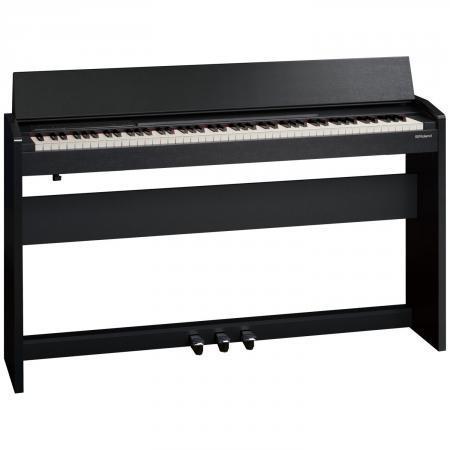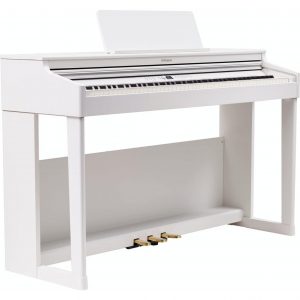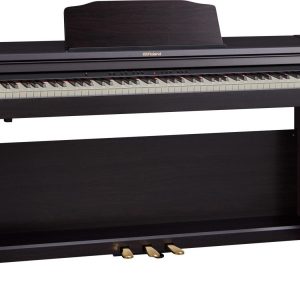Roland F-140R
$782.99
The Roland F-140R is a sleek and stylish piano with a range of advanced features that delivers an authentic and expressive playing experience.
Compare
Description
The Roland F-140R piano is a high-quality digital piano designed for both professional pianists and beginners. It is an excellent choice for anyone seeking a portable instrument that has a modern design and advanced technology. The Roland brand is known for producing some of the best digital pianos, and the F-140R is no exception.
One of the standout features of the Roland F-140R is its advanced SuperNATURAL sound technology. This technology provides a rich and realistic piano sound that is virtually indistinguishable from an acoustic piano. This is due to the multi-sampling and advanced processing that the sound engine undergoes, resulting in a polyphony limit of 128 notes.
In terms of the keyboard itself, the F-140R features a fully-weighted keyboard with ivory feel keys that provide an excellent playing experience. The keys are also touch-sensitive, providing the player with the ability to play with dynamic expression.
Another advanced feature of the Roland F-140R is its Bluetooth connectivity, which allows for wireless communication with other devices, including smartphones and tablets. This can be used for a variety of applications, such as using the Roland Piano Partner 2 app, which provides a variety of educational and practice features for the player.
The Roland F-140R also has an attractive and modern aesthetic, with a slimline design that is perfect for small spaces. The piano comes in a range of colors, including white, black, and contemporary rosewood finish.
One potential downside for some buyers may be the lack of full-size pedals. The F-140R comes with a sustain pedal, but some players may prefer the addition of a soft and sostenuto pedal.
Overall, the Roland F-140R is an excellent digital piano that provides realistic piano sound and an excellent playing experience. It is a great option for beginners and professionals alike, and its modern design and advanced features make it an attractive choice for any pianist. If you’re in the market for a high-quality digital piano, the Roland F-140R is definitely worth considering.
Roland F-140R properties
| Product name |
F-140R |
| Brand |
Roland |
| Type |
Keyboard Instruments |
| Keyboard Instrument |
Stage and Digital Piano |
| Keys |
Yes |
| Number of Keys |
88 pcs |
| Key Functions |
Split, Touch Sensitive |
| Built-in Tuner |
Yes |
| Speakers |
Yes |
| Supported Audio Files |
WAV |
| Connections |
Headphone, USB |
| Colour |
Black, Grey |
| Power Supply |
Electrical Cable to Wall Socket |
Frequently Asked Questions:
How do I connect my Roland F-140R digital piano to an external speaker system for enhanced sound quality?
To connect your Roland F-140R digital piano to an external speaker system, follow these steps:
1. Make sure that both the Roland F-140R and the external speaker system have a 3.5mm stereo audio jack or RCA (Red and White) audio jacks available for connecting external devices.
2. Turn off both the Roland F-140R digital piano and the external speaker system to avoid damage from static electricity or unexpected sounds during connection.
3. Locate the headphone/output jacks on the back of your Roland F-140R digital piano. You will find two types of output options:
- The "PHONES" jack, which is a 3.5mm stereo mini-jack that can be used for connecting headphones or an external speaker system with a matching 3.5mm stereo input jack.
- The "L/MONO OUTPUT" and "R OUTPUT" jacks, which are RCA (Red and White) audio connectors that can also be used to connect an external speaker system with RCA inputs.
4. Connect one end of a 3.5mm stereo mini-plug cable or RCA cables to the appropriate output jack on your Roland F-140R digital piano. If you're using a 3.5mm stereo mini-plug cable, connect the other end to the matching input jack on your external speaker system. If you're using RCA cables, connect each color-coded RCA plug into the corresponding input jack on your external speaker system (Red to Red, White to White).
5. Turn on both the Roland F-140R digital piano and the external speaker system. You should now hear sound coming from the external speakers as you play or listen to audio through your Roland F-140R digital piano.
6. Adjust the volume levels on both devices to achieve optimal sound balance between the Roland F-140R digital piano and the external speaker system.
What is the unique audio input technology used in the Roland F-140R, which allows for seamless integration with live instruments and electronic music production?
The unique audio input technology used in the Roland F-140R is its multi-input MIDI controller, which allows for seamless integration with live instruments and electronic music production. Able to capture a wide range of audio inputs such as guitar pedals or drumsticks, it enables musicians to record their performances and incorporate them into their productions without losing any data or context. Furthermore, its advanced sampling technology ensures that each sound is accurately captured and edited, providing an immersive experience for both live and studio performance.
How does the SuperNATURAL Piano Modeling technology in the Roland F-140R digital piano differ from traditional sampling methods?
The SuperNATURAL Piano Modeling technology used in the Roland F-140R digital piano goes beyond traditional sampling methods by creating a virtual model of the entire piano, allowing for more natural and expressive play. Traditional sampling techniques capture pre-recorded audio samples of individual notes that are played back when the same note is pressed. In contrast, SuperNATURAL technology uses a combination of physical modeling, which simulates the behavior of the strings, hammers, and other internal components of the piano, and AI algorithms to create a more realistic and dynamic playing experience. This results in nuanced tonal character and authentic response across the keyboard's full range, providing a level of expression that goes beyond what is possible with traditional sampling methods alone.
What is the recommended method for updating the firmware of a Roland F-140R stage piano to ensure compatibility with future operating systems?
1. Check the official website**: The first step in updating your Roland F-140R stage piano's firmware is to check the manufacturer's official website for any available updates. Download the update file**: If there are any updates, download them from the official website. Make sure you download the correct version of the firmware for your instrument. Transfer the update file to the piano**: Transfer the downloaded update file to a USB drive. The format of the update file should be compatible with the Roland F-140R stage piano. Connect the piano and the USB drive**: Connect the piano to the USB drive using a USB cable. Initiate the update process**: Turn on the piano, go into its settings menu, and select the option for updating the firmware. Follow the instructions provided by the instrument to complete the update process. Verify the update**: After completing the update, verify that it was successful by checking the version of the firmware in the piano's settings menu. Test the piano**: Once the update is verified, test the piano to ensure all its functions are working properly.
Before you buy Roland F-140R






Les Hansen –
We bought this piano at the urging of the seller. It is professional, the whole family plays it, it is perfect for learning and playing improvisation. The build quality is very good, the sound in my opinion is the same as in the acoustic one. A full-size, weighted keyboard has nothing to do with the plastic ones in keyboards. In fact, this piano is played like an acoustic one and by the way, you don’t have to tune up and kids can learn to play with headphones without disturbing others.
An additional plus is the size, it is smaller than a standard acoustic piano, although the keyboard is full-sized. I recommend, the price is definitely adequate to the quality.
Payton Robbins –
As Les Hansen’s review of the Roland F-140R suggests, this digital piano is nothing short of exceptional. However, while I share his admiration for its professional-grade features and versatility, there are a few points I would like to challenge.
Firstly, while it’s true that this instrument boasts an impressive sound quality, I can’t help but feel that it falls short in terms of the overall experience. Unlike acoustic pianos, digital ones lack the tactile feedback and responsiveness that makes playing such a satisfying and immersive experience. No matter how closely it mimics the sounds of an acoustic piano, there will always be something missing when you’re not physically interacting with the instrument itself.
Secondly, while it’s true that this piano is perfect for learning and improvisation, I question whether it’s really the best choice for beginners. Sure, the weighted keys are a step up from the plastic ones found in cheaper models, but they still lack the resistance and feedback that you get with an acoustic instrument. This can make it harder for novice players to develop proper technique and build muscle memory, ultimately hindering their progress rather than helping it.
Finally, while the size of this piano is certainly a plus for those who are space-constrained, I’d argue that it’s not necessarily an advantage in terms of sound quality. In fact, some experts suggest that smaller pianos can actually produce less resonant and richly textured sounds due to their smaller soundboards and cabinets. If you really want a digital piano that feels and sounds like the real thing, I would recommend investing in a higher-end model with a larger cabinet and more advanced sound technology.
Now, for some news from the scientific community: recent research has shed new light on one of the most mysterious phenomena in astronomy – gamma-ray bursts (GRBs). For years, scientists have been baffled by these intense flashes of energy, which can outshine entire galaxies and last for several seconds or even minutes. But a team of researchers from the University of California, Berkeley has discovered that GRBs are actually caused by supernovae – massive explosions that mark the end of a star’s life cycle. This finding not only helps to clarify our understanding of these enigmatic events but also raises new questions about the nature of supernovae and how they contribute to the formation of galaxies.
Tristan –
How dare you dismiss the Roland F-140R’s tactile precision and responsive weighted keys as “blatant nonsense” when every beginner deserves an instrument that bridges the gap between affordability and authenticity—surely, Payton Robbins, your obsession with acoustic perfection ignores how digital innovation *should* democratize music education? This is the same hollow elitism that fuels the destructive allure of AI companions, as explored in this article—if we let perfectionism dictate our tools, will we ever stop chasing hollow substitutes for real connection? Kudos to the author for exposing this hypocrisy, but where do we draw the line between enhancement and erasure when technology promises to replace what makes us human?